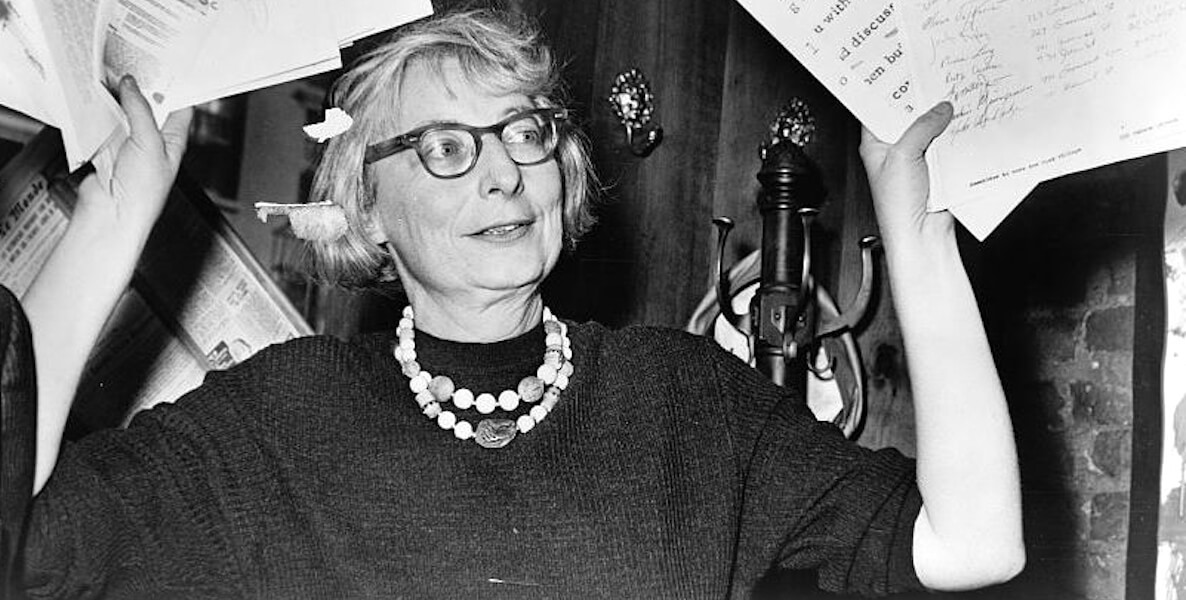With the reopening of the United States fully underway and the Biden Administration aggressively pursuing seismic investments in economic and energy restructuring, it is now urgent to think clearly about how to design and deliver an inclusive recovery.
To that end, we have been looking for guidance from Jane Jacobs by rereading portions of her masterpiece The Death and Life of Great American Cities (originally published in 1961) as well as her lesser known but equally prescient and idiosyncratic, The Economy of Cities (published in 1969).
MORE ON INCLUSIVE RECOVERY
Jacobs’ life and work has often been reduced to her astute observations about the distinctive choreography of urban streets and neighborhoods (e.g., her indelible image of the “sidewalk ballet”). Yet Jacobs was also an astute observer about finance and, particularly, the ability of public and private capital to distort and divide city geography and impede urban progress.
Several insights feel as relevant and piercing today as when they were written more than half a century ago.
Three passages from The Death and Life of Great American Cities that stand out
1. Discriminatory Uses of Capital
First, in a section entitled “Discriminatory Uses of Capital in The Economy of Cities”, Jacobs highlights the abysmal failure to use government housing spending to grow the number and size of Black firms.
A few years ago, New York City and the Federal government undertook, with fanfare, to rehabilitate a group of thirty-seven buildings in Harlem. Black-owned construction firms were theoretically free to bid for the work, but there was a booby trap. All thirty-seven buildings were put into one “package.” Therefore, only firms able to get bonding (required by city and Federal regulations) for so large a job could bid for it, and the only firms that could get the bonding were firms that were already doing big jobs, which meant that they were white contracting firms. If the contracts had been awarded for each building individually—an eminently practical procedure and customary in cases where buildings are being rehabilitated privately in white areas—black contractors could have competed for the jobs. An association of black construction and contracting organizations in New York, struggling to establish a foothold for their work, had begged the city to put the buildings out to bid separately, to no avail. The association, again to no avail, then asked the House of Representatives to investigate this situation and find out why the city was freezing them out of work they were capable of undertaking.
It is painful to read this passage. The United States has been fiddling with supplier diversity since the 1960s; advocates and practitioners alike agree that the results have been lower than expected. In 2017, Black-owned employer firms represented 2.16 percent of all employer firms in the U.S., a far cry from the 13 percent share of our national population that identifies as Black. It is obvious that the actions of multiple governments, financial institutions, agencies, councils, support organizations, advocates and others have not been enough.
In recent years, there has been a burst of innovative energy, both around the procurement of goods and services from consortia of anchor private and civic employers (e.g., Philadelphia Anchors for Growth and Equity, Chicago Anchors for a Strong Economy) and from a small group of infrastructure authorities (e.g., LA Metro, Chicago Aviation Commission). These efforts, while impressive, are still exceptions to the rule and need to be codified and routinized if the country is going to benefit fully from anticipated federal investments in broad categories of infrastructure.
Put simply, “Building Back Better” requires doing things differently.
The importance of perfecting supplier diversity cannot be underestimated. The pandemic has disproportionately devastated Black- (and brown-) owned businesses and many businesses will need new customers and sources of demand if they are going to get back on track. As in prior decades, federal spending in general and federal infrastructure spending in particular hold the promise of providing substitute demand.
Yet challenges to successful efforts abound. Federal funds will flow to multiple public authorities that oversee a disparate set of activities (e.g., schools, transportation, ports, airports, housing). These authorities rarely follow the same template for collecting spending information, setting goals, designing procurement requests and working with potential diverse suppliers to enhance their business plans and access quality capital.
And the same barriers that impeded the ability of Black firms to grow in the 1960’s (e.g., anti-competitive requests for proposals, bonding and insurance barriers, the slow-pay realities of public entities) persist today. As Jacobs implies, reform is hard fought because the headwinds against change are strong, structural, and deeply obscured within the arcana of bureaucratic procedure.
As the Biden Administration and their Congressional allies draft the American Jobs Plan, it is critical to learn from decades of failed supplier diversity efforts. Tweaking at the edges won’t cut it. Rather, market upending disclosure mandates will be fundamental. (Incredibly, we still know more about where banks lend, due to the Home Mortgage Disclosure Act, than where public entities spend).
It is also critical to provide support for high capacity and well-resourced ecosystems of procurement entities, entrepreneurial support organizations and capital providers, highlighting innovative practices that can be replicated, adapted and scaled. Put simply, Building Back Better requires doing things differently.
2. Excess Capital
Second, in a section simply entitled “Excess Capital” (also in The Economy of Cities), Jacobs highlights the importance of what might be called “The Enterprise City” and the large impact of small investments in entrepreneurs. Jacobs was deeply skeptical of the federal penchant to shape “The Physical City” through highways and housing, having experienced first-hand the destructive effect of urban renewal—through the specifically brutal aegis of Robert Moses—in the 1950s and beyond.
Consider this: One of the most expensive things an economy can buy is economic trial and development. What makes the process expensive are the great numbers of enterprises that must find initial capital—which must include those that will not succeed—and the great numbers that must find relatively large amounts of expansion capital as they do begin to succeed… Consider, for a moment, how much investment in new and young enterprises might be bought with $300,000,000. For example:
- 5,000 loans of $10,000 each — ($ 50 million)
- 4,000 loans of $25,000 each — ($100 million)
- 1,200 loans of $50,000 each — ($ 60 million)
- 200 loans of $150,000 each — $ 30 million)
- 100 loans of $500,000 each — ($ 50 million)
- 10 loans of $1,000,000 each — ($ 10 million)
I mention the sum of $300,000,000 because it happens to be the amount of money that was spent in the 1950s upon public housing and related public construction in one district of New York, East Harlem, which has a population of about 200,000 persons. The economic problems of East Harlem are now worse, if anything, than before this expenditure was made. The rates of unemployment, under-employment, welfare—and even the deterioration of housing—have increased, not declined. All kinds of acute practical problems have become more acute. No money to speak of goes into East Harlem for people there to use producing goods and services, developing new work, and becoming economically self-supporting. But this is obviously not owing to lack of capital per se; witness the $300,000,000 made available to the housing projects.
These observations signal a challenge facing Build Back Better plans as they are locally deployed. If the $2.3 trillion American Jobs Plan, for example, is enacted, it is easy to imagine improvements in urban transportation and energy infrastructure as well as a burst of affordable housing production. These are, obviously, positive and long-needed interventions, important to boost overall productivity and reduce the strains of poverty.
But they are not likely, by themselves, to build wealth by growing Black and brown homeowners and owners of business. Those strategies require different, more varied, often smaller forms of capital, both public and private to build upon the foundation set by federal spending.\
3. Gradual and Cataclysmic Capital
Finally, The Death and Life of Great American Cities includes a provocative rumination about the stark differences between what Jacobs called “gradual money and cataclysmic money.” As we recounted a couple years ago:
In Jacobs’ scathing assessment, public and private capital in the 1950s was primarily of the cataclysmic kind. It contributed to the destruction of countless urban neighborhoods both by favoring the suburbanization of population and jobs and by subsidizing large scale “slum clearance” and massive road-building projects. The “death of cities” reflected the absence of public, private and civic capital that financed the “gradual, constant, close-grained changes” that Jacobs argued are the essence of diverse economies, mixed communities and inclusive growth. This absence was clear in communities all across America, from her native Scranton, Pennsylvania to her home in New York City.
The importance of perfecting supplier diversity cannot be underestimated. The pandemic has disproportionately devastated Black- (and brown-) owned businesses and many businesses will need new customers and sources of demand if they are going to get back on track. As in prior decades, federal spending in general and federal infrastructure spending in particular hold the promise of providing substitute demand.
In many respects, Biden’s proposed American Jobs Plan aims to remedy the destructive impact of earlier federal interventions. Secretary Buttigieg has, in fact, said as much. In cities like Detroit, Richmond VA and St. Louis, public and private sector leaders alike are already hatching ambitious strategies to remake the quality of place and repair the fabric of cities torn asunder by highways and the razing of whole neighborhoods.
Unlike in the 1960s, today’s cataclysmic threat comes from private capital: vast pools of resources, domestic and foreign, that are already lining up to buy up large swaths of cities and their affordable apartments or back the proliferation of parasitic retail (e.g., “Dollar Stores”) that provide unhealthy offerings, crowd out local business and undermine regeneration. We began to see this “Cities for Sale” movement in the aftermath of the Great Recession. Given the swelling of Wall Street, the next few years could extend the reach of private capital way beyond high priced coastal cities. Local and federal policymakers alike will need to be attune to this trend and aim to channel this private capital into community wealth-building investments rather than parasitic investments.
Jacobs’ Guidance for Today
In the end, Jacobs’ observations from the mid-20th century hold stark lessons for policy makers. Public capital needs to be smartly and broadly shaped, or it will utterly fail to build community wealth and substantially reduce the pernicious racial and spatial disparities on income, health and wealth that define our country. Public policymakers, at all levels of government, must also take actions to guard against large firms and financial institutions further dominating the economy and distorting economic democracy.
As Jane Jacobs eloquently wrote many times, the essence of prosperous economies and vibrant communities is their embrace of small, locally-owned businesses that generate rather than extract wealth and grow incomes for broad segments of the population. Governments must do more than level the playing field between the large and the small. They must tilt the playing field towards the small and under-served. And they must prod and incentivize private capital to find alternative vehicles that balance institutional investors’ search for market returns with society’s imperative to drive inclusive growth.
We are entering a complex period post pandemic and the size and shape of capital, both public and private, will fundamentally determine whether aspirations of inclusion will be realized or quashed.
Bruce Katz is the founding director of the Nowak Metro Finance Lab at Drexel University. Colin Higgins is a Senior Research Fellow at the Nowak Metro Finance Lab.
Photo by Phil Stanziola / Library of Congress / Wikimedia Commons



